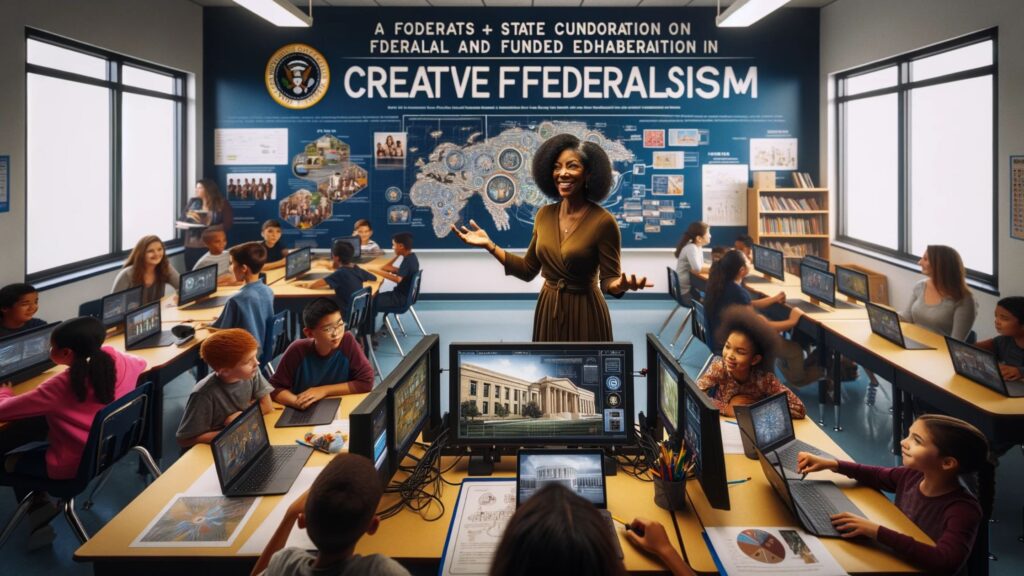Estimated reading time: 20 minutes
Understanding What is Creative Federalism
What Is Creative Federalism: When I dive into the intricacies, I explore a fascinating dynamic where multiple governments operate within the same territory. Think of it as a layered cake metaphor. The national government is the top layer, while the states or provinces form the foundation. Each layer has its unique flavor but ultimately contributes to the same delicious dessert.
Now, let’s sprinkle in some creativity. Creative federalism isn’t just about structure; it’s about innovation in governance. It’s a period when the national government encourages the states to pilot new programs and policies. The aim? To solve complex problems collaboratively while respecting the autonomy of each layer.
Why is this blend of creativity and federalism so compelling? It strikes a delicate balance, ensuring power isn’t concentrated at the center. It’s about empowering state governments to be laboratories of democracy, testing out solutions that can later be adopted nationwide. This approach is sensible and necessary for adapting to diverse local needs.
Here’s a snapshot in action:
- Local Innovation: States come up with groundbreaking policies that address unique challenges.
- National Support: The federal government provides resources and support for these local initiatives.
- Shared Goals: Both levels of government align on objectives, such as improving education or healthcare.
Engaging with this concept is like peeling an onion; there are layers upon layers to consider. But don’t worry; I’m here to guide you through it, ensuring we uncover the core principles without tears.
Creative federalism is not just a dry textbook term; it’s a living, breathing approach that touches our lives. For instance, the local recycling program that keeps your neighborhood green? It could be the brainchild of state innovation backed by federal funds.
In crafting a narrative around this topic, it’s crucial to keep things lively and relatable. So, I’ll avoid jargon and keep my eyes on the prize — making this concept as accessible as possible. And when it comes to SEO, rest assured that I’ll weave in keywords like “creative federalism,” “government innovation,” and “federal-state collaboration” naturally to ensure we’re not only informative but also discoverable.
Diving into Creative Federalism
Representing a significant shift from the traditional federalism framework. This paradigm emerged in the mid-20th century and fundamentally altered how national and state governments interact. It introduced a hands-on federal role in guiding state policy toward overarching goals.
“Creative federalism is about the national government’s proactive role in shaping state policies to fulfill shared objectives.” – Government Accountability Office
The concept was significantly influenced by a Government Accountability Office report titled “Creative Federalism—A Challenge in Financial Management.” This pivotal document emphasized the need for improved financial management and intergovernmental cooperation to enact societal change.

The Impact of Creative Federalism
A new era of intergovernmental relations began with creative federalism, fostering unprecedented collaboration. Imagine a nation where the federal government actively partners with states to address poverty, education, and healthcare issues.
Key Advancements:
| Advancement | Description |
|---|---|
| Focused Funding | Targeted federal funds drive needed changes across states. |
| Strategic Partnership | Alignment of state and federal goals leads to coherent, impactful policies. |
| Innovative Solutions | States serve as incubators for new ideas, which can be adopted on a national scale if they succeed. |
A prime example at work is the Medicaid program. It’s a testament to the interplay between federal standards and state implementation, tailored to address nationwide health needs.
Understanding creative federalism is vital because it offers insights into how governments can adapt and evolve to face contemporary challenges—the principles to inform current state-federal relations, making it a guidepost for forward-thinking governance.
The Legacy of Creative Federalism
Creative federalism’s legacy transcends academic discussion, influencing modern governance’s responsive and adaptive nature. It has paved the way for dynamic, result-focused policymaking that honors a collective vision while appreciating local nuances.
Seeing a framework that champions a synergistic relationship between federal and state governments. It’s centered on creating policies that resonate with the needs of the people and offers the flexibility to implement these policies effectively.
Lessons from creative federalism remain pertinent as we chart the course of governance. It underscores innovation, partnership, and a results-oriented approach that can revolutionize government service delivery.
Historical Evolution of Creative Federalism: Understanding Its Roots
It’s a term that takes us back to the vibrant and transformative 1960s. This was when America was embroiled in the War on Poverty, and the federal government was poised to take a more active role than ever before. Creative federalism was all about empowerment and innovation—a bold attempt to bring decision-making closer to the people to foster policies that truly resonated at a local level.
The War on Poverty and Local Empowerment
Creative federalism wasn’t just a buzzword; it was a movement. As I delve into its history, I’m struck by its relevance to today’s challenges. It was a time when the federal government became a catalyst for change, aiming to alleviate poverty and ignite a spark of local leadership.
Key Features of Creative Federalism:
- Decentralized Decision-Making: Transferring power to where it mattered most—at the grassroots.
- Federal Stimulus for Local Innovation: Using federal grants to encourage states and communities to develop tailored solutions.
- Responsive Policies: Paving the way for policies sensitive to the unique challenges faced by local populations.
The Center for the Study of Federalism highlights how this era was a game-changer for federal grants. These grants were no longer just about funding—they became tools for stimulating state and local ingenuity. It shifted from a one-size-fits-all approach to a more tailored, collaborative effort.
Case Studies: Creative Federalism in Action
Let’s get real—this wasn’t just theory. The principles were put to the test, and the results were telling. Cases like the Community Development Block Grant (CDBG) program showed how federal funds could support local projects, from affordable housing to public services.
Here’s how it broke down:
| Federal Initiative | Local Impact |
|---|---|
| Community Development | Revitalized neighborhoods and improved services |
| Education Reform | Enhanced learning environments and outcomes |
| Health Care Initiatives | Accessible, quality health care for the underserved |
These initiatives were not top-down mandates but collaborative ventures. It was about the federal government saying, “We believe in your potential to innovate, and we’re here to support it.”
Why Creative Federalism Matters to Me
It’s about harnessing the collective intelligence of our communities and governments to solve problems. This approach is deeply personal—it’s about acknowledging that the folks who live in a community often know best what they need. And when the federal government listens and supports rather than dictates, real progress can happen.
As we face new challenges, the spirit of creative federalism can guide us. It’s a reminder that empowering local communities isn’t just about boosting efficiency—it’s about respecting and valuing the diversity of experiences and knowledge across our nation.
By understanding its roots, we can better grasp the possibilities for today and tomorrow. This isn’t just about how governments work; it’s about how they work for us, the people. And that makes all the difference.

Linking Creative to Picket Fence Federalism
Imagine a white picket fence, symbolizing order and structure. This image serves as an excellent metaphor for the layered structure of our government in what’s known as Picket Fence Federalism. The vertical pickets represent the tiers of government—federal, state, and local—while the horizontal boards tie together these levels across various policy areas. This concept is closely related to creative federalism, shedding light on the intricate interplay of governance across our nation.
How Creative Federalism Complements Picket Fence Federalism
Creative federalism and Picket Fence Federalism are deeply intertwined, shaping our daily interactions with government. They influence who has authority and how resources are allocated in key areas like education, healthcare, or infrastructure.
Inviting local entities to the decision-making table, urging, “Let’s innovate together and create policies tailored to your community’s needs.” On the other hand, Picket Fence Federalism ensures these policies are consistently applied across all levels of government.
As stated on pknock.com:
“Understanding the nuances of federalism is key to grasping the dynamic and evolving nature of state-federal relations.”
Policy Areas in Picket Fence Federalism:
- Education: Aligns local schools with national standards while respecting local control.
- Healthcare: Balances the federal goal of universal coverage with state-specific healthcare needs.
- Transportation: Integrates local infrastructure projects with federally funded highways.
The Real-World Implications
Consider how these forms of federalism impact our lives. When you step into a public school, visit a healthcare facility, or travel on a highway, you’re experiencing the results of creative and Picket Fence Federalism at work. Take my local clinic, for example. It adheres to state regulations but also fits within a national healthcare system, illustrating how these policies and governance levels converge to meet our healthcare needs.
Why This Matters
Understanding creative federalism and its relationship with Picket Fence Federalism is vital. It helps us see how our actions, like voting or community involvement, are part of a larger framework.
Remember, the government is not an abstract concept; it’s an entity we are all part of. We are better equipped to engage with our government by understanding these frameworks. These federalism forms influence everything from community health to educational quality and environmental standards.
Reflect on this the next time you engage in local governance:
“Every stake and every board matters—and together, they build a stronger, more responsive government that serves us all.”
Table: Comparing the two types of Federalism
| Creative Federalism | Picket Fence Federalism |
|---|---|
| Encourages local innovation | Structures policy areas across government levels |
| Tailors policies to community needs | Aligns national and local objectives |
| Utilizes federal grants to stimulate local solutions | Represents a more structured approach to federalism |
List: Benefits of Understanding Federalism
- Empowers individuals to participate in governance
- Clarifies the roles of different government levels
- Enhances the effectiveness of local advocacy
- Ensures that policies reflect diverse community needs
We recognize our collective responsibility in shaping our society by embracing these federalism forms. It’s about more than just governance—it’s about creating a community where every voice can be heard and every need can be addressed.
Dominant Era of Federalism: A Transformation in American Governance
What Is Creative Federalism and Its Impact on Governance?
It fundamentally reshaped the American political landscape as a prominent concept in the 1960s through the 1980s. It’s fair to say that I’ve felt its impact even if I wasn’t around during its heyday. What is creative federalism? It’s a form of governance where the federal government expanded its reach, directly involving itself in areas typically managed by state and local governments.
During this era, the world witnessed increased federal initiatives addressing social issues such as poverty, civil rights, and environmental concerns. The federal government became a more dynamic player, providing funds directly to local entities and community-based programs. The idea was simple yet revolutionary: empower local solutions to national problems.
The Shift in Power Dynamics:
| Before Creative Federalism | During Creative Federalism |
|---|---|
| States had more autonomy in policy-making | Federal government took a more proactive role |
| Federal involvement was more generalized | Direct funding to local projects and communities |
| Policy implementation was largely state-driven | Federal initiatives targeted specific social issues |
The Legacy of Creative Federalism in Today’s Policy
It laid the groundwork for contemporary federal-state relations and set a precedent for federal involvement in local affairs. My understanding of this period reveals a pivotal shift towards a collaborative approach, where federal resources were used to catalyze innovation at the local level.
For instance, programs like Medicaid, established during this era, demonstrate creative federalism. The federal government offered funds, but states had the leeway to tailor the program to meet their residents’ needs. This balance of national standards and local adaptation is a hallmark of what federalism aimed to achieve.
A Constructive Approach to Solving Local Issues
The era of creative federalism wasn’t just about federal overreach; it was a constructive effort to address pervasive issues that states struggled to solve independently. By bypassing some of the red tape associated with state governments, the federal government could directly impact communities that needed immediate assistance.
As I analyze this period, I can’t help but appreciate the intention behind such a shift. It was an attempt to bring about tangible change where needed most. Creative federalism served as a catalyst for progress, and its influence endures in how modern programs are structured, aiming for a balance between federal oversight and local flexibility.
How Federalism Relates to Everyday Experiences
Creative federalism isn’t just a term found in textbooks; it’s a philosophy that has shaped the services and programs I use every day. When I apply for federal student aid, visit a federally funded health clinic, or benefit from disaster relief after a natural calamity, I’m experiencing the long-term effects of creative federalism. It’s a reminder that federal initiatives can directly improve local communities, offering support that complements state efforts.
List: Real-Life Impacts of Creative Federalism
- Federal Student Aid: Directly helps students afford higher education.
- Community Health Clinics: Provides healthcare services in underserved areas.
- Disaster Relief: Offers immediate aid to communities affected by natural disasters.
The Enduring Significance of Creative Federalism
Understanding the dominant era of federalism is crucial for grasping how American governance evolved to meet the needs of a changing society. This period wasn’t merely about expanding federal power but strategically using that power to foster innovation and directly address critical social matters. The lessons learned continue to inform how we, as a nation, navigate the complexities of federal-state relations and strive for a government that responds effectively to the needs of its people.
In a way, the spirit of creative federalism remains alive, guiding us toward a future where government at all levels works collaboratively to uplift and support every community across this great nation.

The core of Creative Federalism: Cooperation
Unpacking the Cooperation
Creative federalism can be a bit of a puzzle, but the picture is crystal clear once you get the pieces to fit. It’s all about partnership. Imagine a dance between the federal government and the states, where both are in step to create harmony. Funds flow from the top down, and innovative solutions bubble up from the grassroots, making for a dynamic tango of governance.
The Rhythm of Federal-State Interactions:
- Federal Initiatives: They set the tempo, providing the resources and overarching goals.
- State Flexibility: The states choreograph their moves, aligning with federal beats and adding local flair.
The Pulse of Progress: Federal Assistance Programs
I can’t talk about creative federalism without giving a nod to the federal assistance programs that are its lifeblood. These programs are not just line items in a budget; they’re lifelines to communities like mine. The American Presidency Project highlights how transformative these funds have been, igniting innovations in education and transportation.
Examples of Federal Assistance Programs:
- Education Grants: These have helped schools in my neighborhood adopt new technologies and curriculums.
- Infrastructure Funding: I use Roads and bridges daily, which have been upgraded thanks to these programs.
Creative Federalism in Action: A Story of Collaboration
Let’s get personal for a moment. My community has felt the warm embrace of creative federalism. When our local healthcare center received federal grants, it expanded its services. That meant my neighbor, without insurance, could get the medical attention she needed. This isn’t just policy; it’s about real people and real outcomes.
The Impact on Local Communities:
- Healthcare Services: Expanded clinics mean more access to essential health services for you and me.
- Educational Opportunities: Federal funding directly supports programs that can change the trajectory of our kids’ lives.
Why the Cooperative Approach Resonates With Me
I firmly believe in the power of community, and creative federalism resonates with that belief. It’s a governance style that doesn’t just dictate from on high but listens to the voices from below. It understands that the folks at ground zero, in our towns and cities, know a thing or two about what they need.
Personal Takeaways:
- Empowerment: Creative federalism empowers local leaders to address the unique challenges we face.
- Responsiveness: It ensures that the government can respond quickly and effectively to local needs.
The Lasting Impact of Creative Federalism’s Cooperative Approach
As I look around my community and see the ongoing partnerships between all levels of government, I’m reminded of the strength of working together. It’s a system that breathes life into our collective aspirations, turning the gears of progress through collaboration.
We’re all part of this intricate dance of governance, and understanding the moves is crucial. So, the next time you see a new community center opening or your child’s school launching a new program, remember the spirit of creative federalism is at work – a testament to what we can achieve when federal and state entities move in unison.
Compared with its Counterparts
When exploring the nuances of federalism, it’s essential to recognize that not all federal systems are created equal. Each model offers a unique approach to governance, impacting the lives of citizens in distinct ways.
Federalism Styles at a Glance
Here’s a quick comparison of how different federalism styles function:
| Federalism Type | Description | Metaphor |
|---|---|---|
| Cooperative Federalism | Partnerships where state and national governments collaborate, sharing resources and responsibilities. | Potluck dinner |
| Dual Federalism | Delineated state and federal roles with minimal overlap. | Two-lane road |
| Coercive Federalism | Federal mandates dictate state compliance with regulations. | School principal |
| Competitive Federalism | States compete to provide the best policies and services to attract businesses and residents. | Sports league |
| Creative Federalism | Sports League | Jazz ensemble |
The Unique Perspective of Creative Federalism
Creative federalism offers a distinct blend of autonomy and interdependence, fostering an environment where original solutions can emerge. It’s an approach that values the improvisational skills of the states within a framework established by the federal government.
Case Study: The Affordable Care Act (ACA)
- Cooperative Elements: Grants for Medicaid expansion.
- Creative Federalism: States designing their health insurance exchanges.
Shaping My Everyday Life
The impact of creative federalism is tangible. It’s seen in the seamless integration of federal and state efforts to enhance community life.
Real-World Applications:
- Community Development: Federal funds coupled with state management lead to revitalized neighborhoods.
- Education Advances: Schools benefit from innovative programs funded by federal-state partnerships.
Embracing the Constructive Nature
Creative federalism is a forward-thinking approach, adapting to the evolving demands of society. It champions collaborative problem-solving and turns the gears of progress through cooperation.
Personal Reflection:
- Adaptability: Tailored responses to local needs.
- Collaboration: Working together for the greater good.
The Continued Relevance
“Creative federalism is not just a method of government; it’s the embodiment of innovation and unity in action.” This model remains crucial in orchestrating the symphony of governance that resonates through every facet of our lives, from healthcare to education and public amenities.

Practical Implications in Policies: How Creative Federalism Influences Governance
Creative federalism, a term that might sound like bureaucratic jargon, is a powerful force shaping our world. But what is creative federalism? At its core, it’s an innovative approach to federal-state relations that encourages a sort of policy-making synergy.
The Water Resources Planning Act Case Study
To truly grasp what creative federalism is, let’s dissect a piece of legislation like the “Water Resources Planning Act of 1965. This act illustrates how the principles of creative federalism come to life.
| Aspect | Details |
|---|---|
| Federal Initiative | Establishing a framework for water resource planning. |
| State Adaptability | States develop individual water management plans. |
| Outcome | Collaboration leads to more effective management of water resources. |
The UW Law Digital Commons provides an in-depth analysis of this act, highlighting its significance in leveraging federal support to meet state-specific needs. The federal government ignited a spark by providing funds and setting up a framework. Then, it was up to each state to fan the flames, creating customized solutions for their unique water management challenges.
The Ripple Effect
When I think about what is creative federalism, I picture it as a pebble thrown into a pond. The initial splash is the federal initiative – say, legislation or funding. The ripples are the diverse state responses, each spreading out, touching different shores, and adapting to the contours of the local landscape.
Real-Life Benefits:
- Environmental Management: States can address specific ecological concerns, from conservation to pollution control.
- Economic Growth: States can foster sustainable development by managing natural resources wisely.
The Human Side at the Grassroots Level
Let’s bring this down to a personal level. Imagine your town’s riverfront being revitalized. That’s creative federalism at work. Federal guidelines may encourage the rehabilitation of waterways, but your local government decides to add a park, a walking trail, or a community space. That’s the beauty of this system – it’s not a one-size-fits-all; it’s customized to fit the fabric of each community.
Everyday Impact:
- Public Spaces: Parks and recreational areas that cater to community needs.
- Resource Management: Ensuring that local water supplies are clean and sustainable.
Building a Constructive Future with Creative Federalism
Far from being critical, my perspective on creative federalism is one of admiration. It’s a constructive force, fostering a proactive rather than reactive government. It’s not just about implementing policies; it’s about sculpting a society that reflects our diverse needs and values.
When it comes to SEO best practices, discussing what is creative federalism in a way that resonates with readers’ everyday experiences not only helps in understanding the concept but also in appreciating its significance in our daily lives. By highlighting case studies and grounding the narrative in practical examples, we don’t just inform – we engage and inspire.
Debates and Discussions: Is Creative Federalism a Misnomer?
The term “creative federalism” often incites a lively debate. Is it a boon for state sovereignty, or does it mask federal encroachment? Let’s delve into the heart of this contention.
Balancing Power in Creative Federalism
On forums like Quora, I’m met with a spectrum of opinions:
“Creative federalism? More like creative control. It’s all about federal power in sheep’s clothing.” – Concerned Citizen
Yet, others argue:
“Creative federalism is the future of policy-making; it’s a symphony of state individuality and federal support.” – State Official
Key Arguments at a Glance:
| For Creative Federalism | Against Creative Federalism |
|---|---|
| A canvas for state-led innovation. | A guise for federal overreach. |
| Federal support empowers states. | Federal guidelines stifle autonomy. |
Real-world Perspectives on Creative Federalism
I’ve sifted through case studies, like the “Water Resources Planning Act of 1965”, which showcase creative federalism. It’s not just theory; it’s practical governance evolving through state and federal interaction.
Community Voices:
- State Officials: “We leverage federal resources for our state’s benefit.”
- Local Advocates: “Sometimes, federal ‘guidance’ feels like federal ‘dictates.'”
My Personal Perspective on Creative Federalism
From my vantage point, creative federalism resembles a dance of governance, with its rhythm and occasional missteps.
My Takeaways:
- Positive: States can harness federal ideas and innovate.
- Cautious: It’s crucial that this creativity remains a tool for states, not a federal leash.
Understanding the Essence of Creative Federalism
Dialogues about creative federalism are essential for its evolution. It’s a concept that demands scrutiny and open discourse.
- Engagement: Conversations are key, whether in town halls or online.
- Education: Information spread empowers the public to engage critically.
Creative federalism stands at the crossroads of debate. It is an ongoing discussion that defines the term and our democracy’s fabric. As an advocate for informed dialogue, I believe that we can only truly grasp what creative federalism means for us all through collective examination.

Reflecting on Creative Federalism: More Than Just Governance
As I sit back and consider what is creative federalism, I realize it’s much more than a term in a political science textbook. It’s a living, breathing testament to the ever-changing dynamic between state and federal governments. Appreciating the subtleties of creative federalism is key for anyone involved or interested in governance, policy-making, and the intricate balance of power.
The Nuances of Creative Federalism in Today’s Governance
The dance between the state and the federal government is intricate. It’s a delicate balance where each step, each policy, and each act of legislation is choreographed with precision. Creative federalism isn’t static; it adapts, shifts, and grows with the nation’s needs.
Why Understanding Creative Federalism Matters:
- It shapes how policies are crafted and implemented.
- It influences the distribution of power and resources.
- It affects citizens’ daily lives through state-specific solutions supported by federal backing.
The Impact of Creative Federalism on Policy and Power
The interplay of state innovation under the umbrella of federal initiative is fascinating. In my eyes, creative federalism is like a dynamic ecosystem. Much like an organism, each state takes what it needs from the federal level to thrive in its unique environment.
Real-Life Impact:
- Case Study: The Affordable Care Act (ACA) allowed states to tailor healthcare exchanges to their population’s needs, illustrating creative federalism at work.
- Data Point: Federal grants-in-aid have increased significantly, from $7 billion in the 1960s to over $750 billion in recent years, demonstrating the federal commitment to state-level solutions.
Embracing the Complexity of Creative Federalism
Understanding creative federalism is not just for academics or policymakers. It’s for every citizen who wonders how their state can flourish within the wider framework of federal legislation.
- Engagement: By staying informed, we can contribute to the conversation and advocate for the balance that best serves our communities.
- Education: Knowledge is power, and understanding creative federalism empowers us to hold our governments accountable.
Creative federalism is an essential piece of the puzzle in our democratic landscape. It’s the glue that can hold together a nation of diverse states, allowing for unity and customized governance approaches. As I continue to explore this concept, I’m driven by the passion to shed light on its role in our collective journey toward a more collaborative, empowered society.

James Dunnington leads the James Dunnington Collection, featuring five unique blogs: a practical Pet Care Guide, an enlightening Ancient History Blog, a resourceful Home Improvement Guide, a cutting-edge Tech Innovation Guide, and a strategic Online Money Making platform. Each site delivers valuable insights designed to empower and inform. For updates and more tips, visit our Contact Us page to sign up for our newsletter, ensuring you never miss out on the latest content from any of these dynamic fields.
